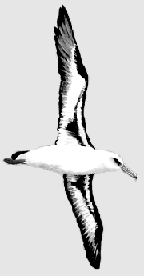Ka'upu / Albatross
 The largest seabird, the manu ka'upu, or albatross, can soar for hours,
with wings outstretched and motionless (wing span = 6-7 feet), and remain
at sea for months or even year-round, ranging over thousands of miles.
Because of their
hollow bones, they weigh only a few pounds.They fly too fast to feed
on the wing, so they settle on the water, dipping their heads to feed.
They eat fish eggs, fish, squid, and crustaceans. Cold-ocean birds, they
are rarely seen feeding in the tropics. Birds that nest in Hawai'i fish
the cold waters of the North Pacific.
The largest seabird, the manu ka'upu, or albatross, can soar for hours,
with wings outstretched and motionless (wing span = 6-7 feet), and remain
at sea for months or even year-round, ranging over thousands of miles.
Because of their
hollow bones, they weigh only a few pounds.They fly too fast to feed
on the wing, so they settle on the water, dipping their heads to feed.
They eat fish eggs, fish, squid, and crustaceans. Cold-ocean birds, they
are rarely seen feeding in the tropics. Birds that nest in Hawai'i fish
the cold waters of the North Pacific.
Albatrosses live long, mate
for life, and produce only one egg every one or two years. They produce
eggs from 7 or 8 years old until their 20's. Most of the
world's Laysan (pictured at the right) and Black-footed albatrosses nest
on the Northwestern and western Hawaiian Islands (Kaua'i, Ni'ihau,
Ka'ula and O'ahu, around Ka'ena Point).
Once at risk because they were hunted for their feathers,
albatross populations have recovered and the bird is no longer considered
endangered. Some albatrosses are killed when they swallow hooks
baited with squid trailing from long-line fishing boats trolling for a'u, or swordfish. The birds are dragged into the
water and drowned after swallowing the hooks. The
U.S. Fish and Wildlife Service is working with longliners to come up with
techniques to protect the birds, such as laying line at night, weighting
hooks so that the bait is below the surface out of reach of the albatross,
or disguising the bait with blue dye.(Jan TenBruggencate, "Help sought for
over-eager albatross" Honolulu Advertiser, Feb. 16, 1999 A1+). In
1999, it was reported that adult albratrosses were abandoning their
eggs and their young on Kaua'i and the Northwestern Islands of Hawai'i,
perhaps because a shortage of food at their fishing grounds is forcing
them to feed for survival rather than returning to their nests to feed
their young (Jan
TenBruggencate, "Albatrosses abandoning nests in record numbers," Honolulu
Advertiser, march 7, 1999, A1+).
In some cultures sailors believe
that these solitary flyers
of the open ocean are the souls of dead sailors, and that
killing an albatross will bring bad luck.
 The largest seabird, the manu ka'upu, or albatross, can soar for hours,
with wings outstretched and motionless (wing span = 6-7 feet), and remain
at sea for months or even year-round, ranging over thousands of miles.
Because of their
hollow bones, they weigh only a few pounds.They fly too fast to feed
on the wing, so they settle on the water, dipping their heads to feed.
They eat fish eggs, fish, squid, and crustaceans. Cold-ocean birds, they
are rarely seen feeding in the tropics. Birds that nest in Hawai'i fish
the cold waters of the North Pacific.
The largest seabird, the manu ka'upu, or albatross, can soar for hours,
with wings outstretched and motionless (wing span = 6-7 feet), and remain
at sea for months or even year-round, ranging over thousands of miles.
Because of their
hollow bones, they weigh only a few pounds.They fly too fast to feed
on the wing, so they settle on the water, dipping their heads to feed.
They eat fish eggs, fish, squid, and crustaceans. Cold-ocean birds, they
are rarely seen feeding in the tropics. Birds that nest in Hawai'i fish
the cold waters of the North Pacific.